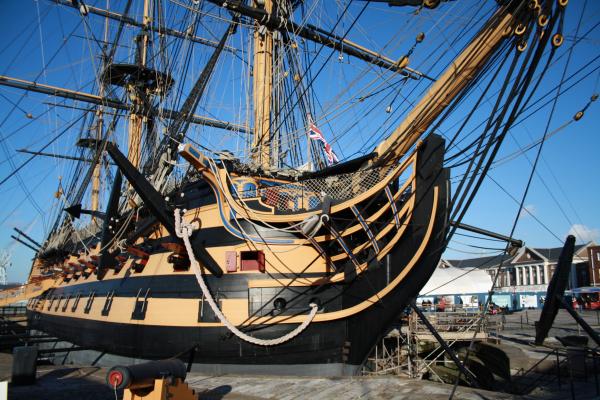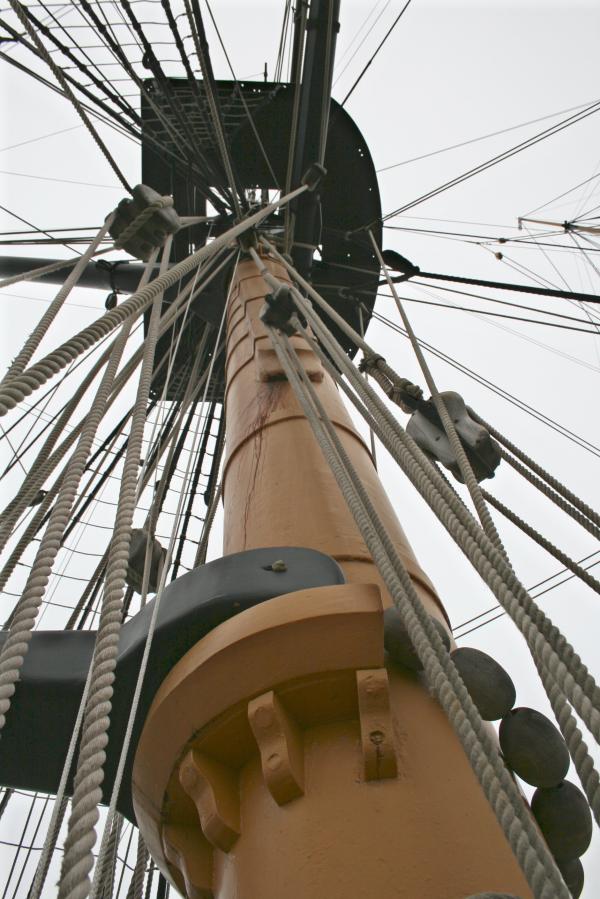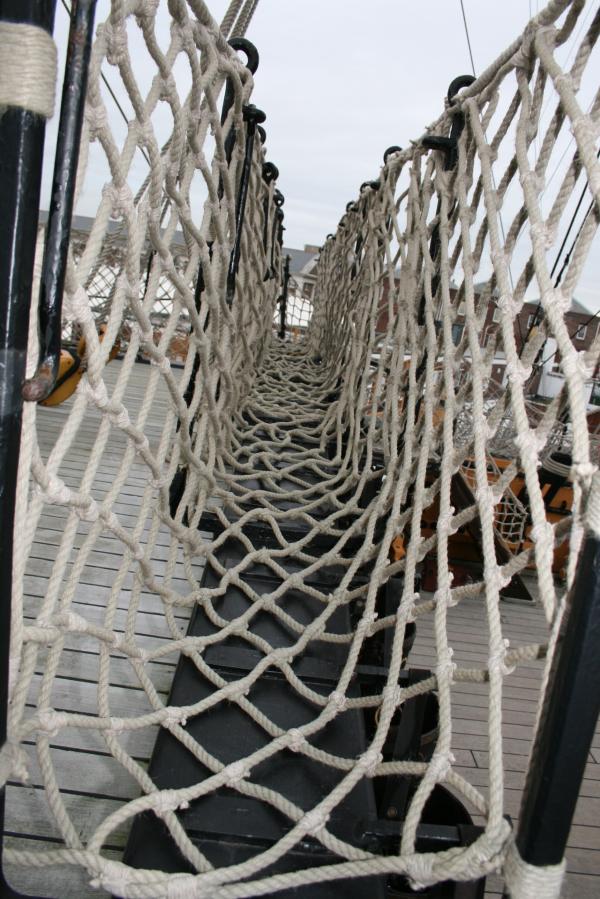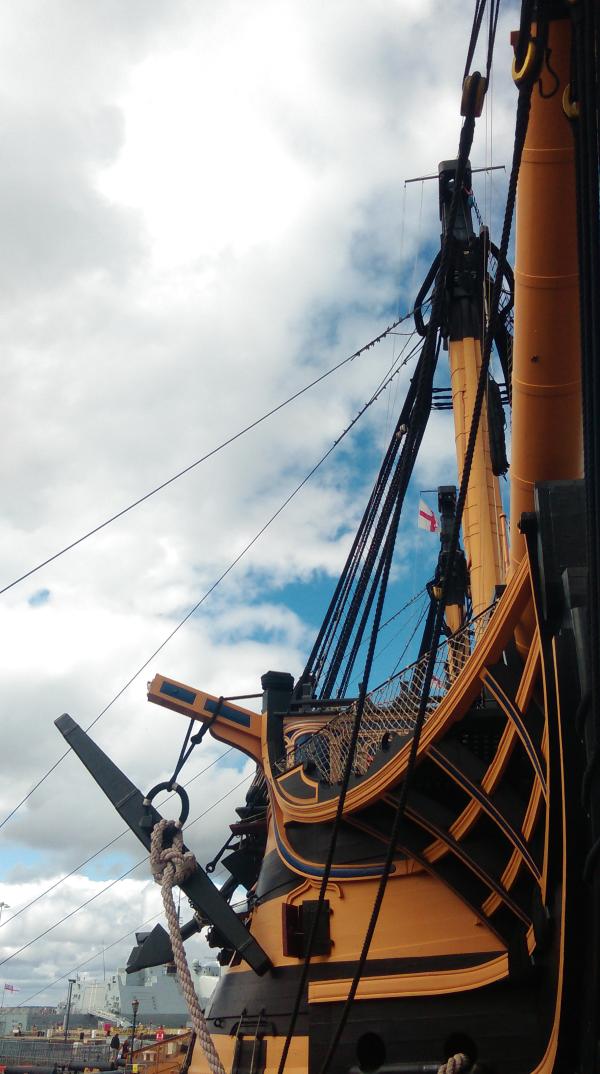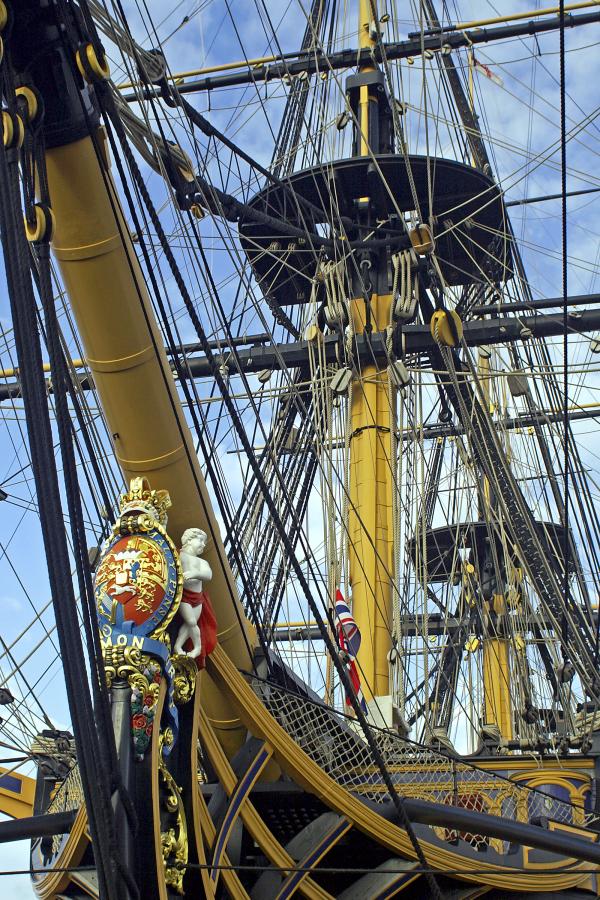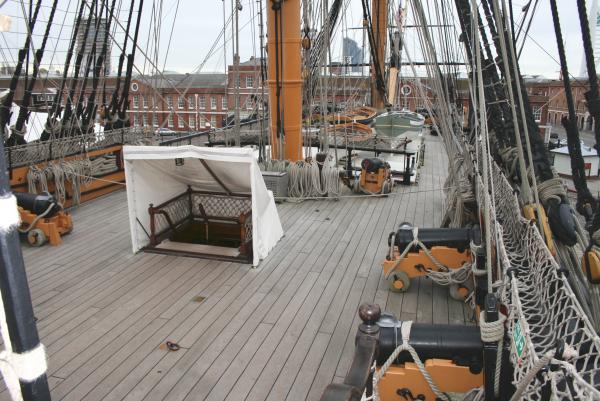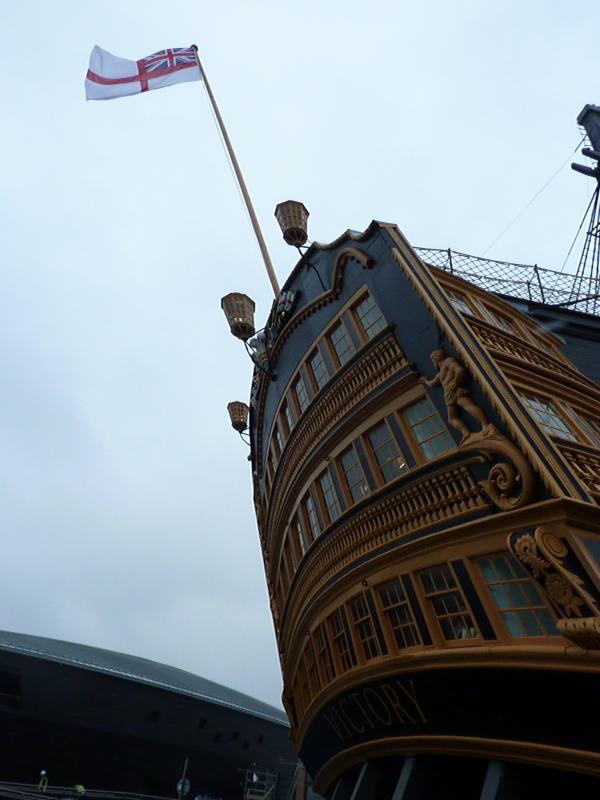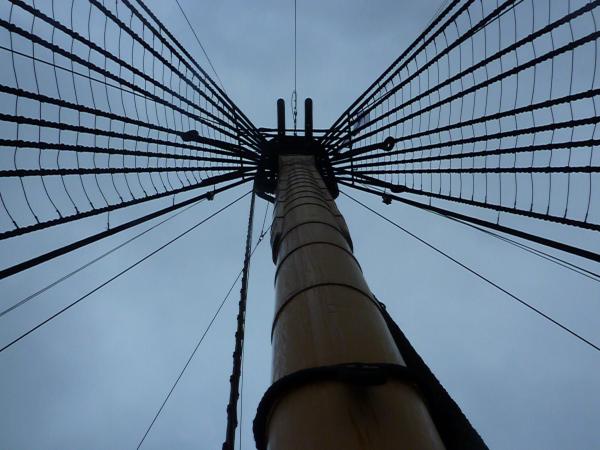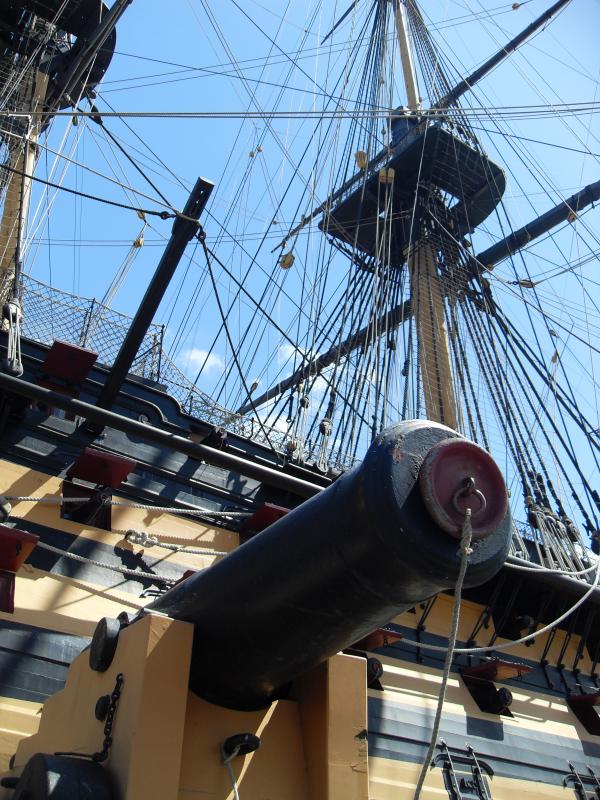
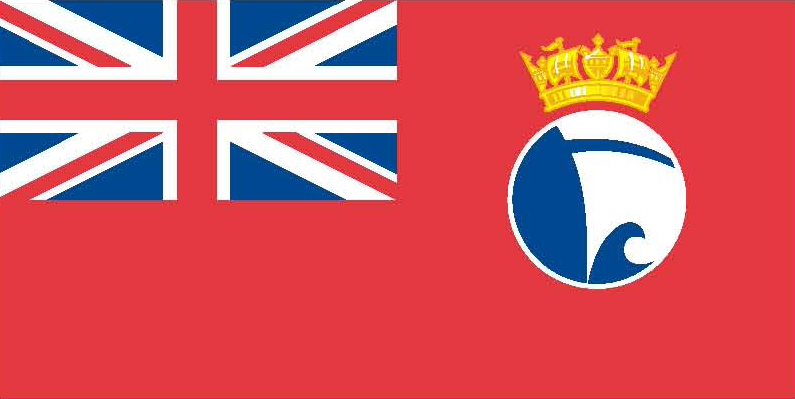
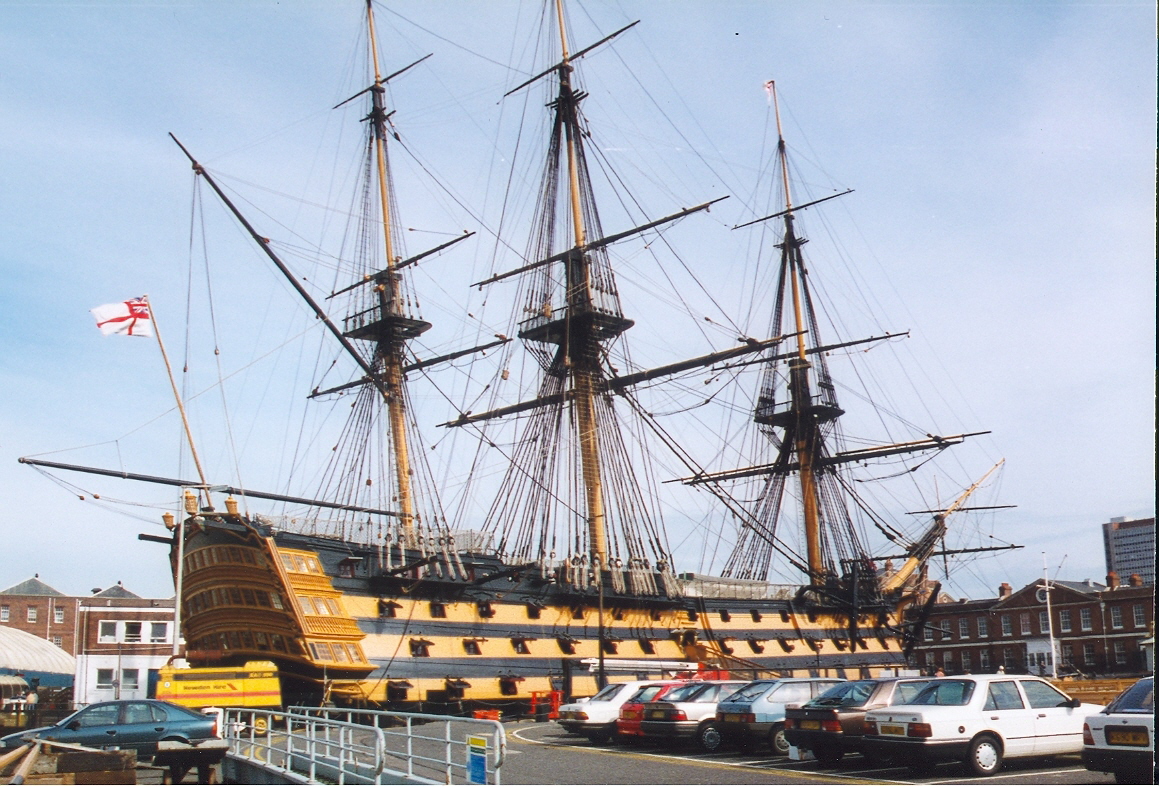
Details
Construction
Dimensions
History
HMS VICTORY was designed by Sir Thomas Slade, Senior Surveyor of the Royal Navy. She was launched in 1765 and used around 6000 trees of which 90% were oak, the remainder being elm, pine and fir. She was not commissioned until 1778 and this long period of weathering resulted in her timbers being well seasoned which was a major reason for her long life. She was a First Rate Ship of the Line with an outfit of 100 guns on 3 decks.
HMS VICTORY was in active service for 34 years. She served as the flagship to a number of distinguished Admirals and fought at the first Battle of Ushant in 1778 (Keppel), the Second Battle of Ushant in 1781 (Kempenfelt) and the Battle of Cape St Vincent in 1797 (Jervis). In 1797, she was pronounced unfit for further active service and was due to be converted to a hospital ship. However, when HMS IMPREGNABLE was lost in October 1797 leaving the Admiralty short of a First Rate, the decision was taken to refit VICTORY which took place at Chatham between 1800-1803.
As part of an extensive reconstruction, extra gun ports were added, increasing her guns from 100 to 104, the magazine was lined with copper, the masts were replaced and the paint scheme changed from red to the black and yellow seen today. She sailed for Portsmouth in April 1803 and Nelson hoisted his Flag onboard in May 1803 as Commander-in-Chief of the Mediterranean Fleet. Admiral Lord Nelson was VICTORY’s most famous Admiral.
On 21 October 1805, she led the British Fleet under his command into battle against a Franco-Spanish force off Cape Trafalgar. Nelson was shot at the height of the battle and died at 16.30 when victory was assured. VICTORY suffered a lot of punishment, 57 men were killed and 102 wounded, and the ship was so badly damaged that she had to be towed to Gibraltar for emergency repairs before returning home with Nelson’s body onboard.
After further service in the Baltic and off the coast of Spain, VICTORY was placed in reserve in 1812 and was moored off Gosport as a depot ship. Flagship of the Port Admiral, Portsmouth from 1824, she became flagship of the Commander-in-Chief in 1899. She then slowly deteriorated at her moorings until a campaign to save her was started in 1921 by the Society of Nautical Research (SNR).
In 1922 she was moved into No 2 dock Portsmouth, the oldest drydock in the world, for restoration. The work was completed in 1924 and preservation continued under the supervision of the Society for Nautical Research (SNR). The ship subsequently underwent another extensive restoration programme to make her appearance as close as possible to that at Trafalgar, for the bicentenary of the battle in October 2005. She is still in commission as the flagship of the Second Sea Lord/Commander-in-Chief Naval Home Command.
Source; David Newberry, Advisory Committee, December 2008
Significance
- What is the vessel’s ability to demonstrate history in her physical fabric?
Evidence for designs, functions, techniques, processes, styles, customs and habits or uses and associations in relation to events and people. How early, intact or rare these features are may impact on significance.
HMS VICTORY is a unique and extremely complex archaeological artefact whose fabric retains evidence of its construction, modification, repair and conservation between 1759 and the present day. Despite the high proportion of loss of historic fabric since 1922, its unique survival gives it exceptional significance.
A survey of the shipwright timber marks on VICTORY'S fabric recorded a total of 831 marks – 673 in situ on the vessel, and a further 158 recorded on material removed from the ship and retained in store. This represents by far the greatest single concentration of timber marks on a ship from the Age of Sail currently known anywhere in the world. Dendrochronological dating of timbers and a programme of paint analysis have added to the evidence gained from the timber marks to indicate the extent of extant fabric which dates to the vessel’s service career.
The detailed archaeological study of the shipwright’s marks on historic timbers surviving in the ship has not only provided evidential value about the fabric of the ship itself but has contributed to a greater understanding of the wider subject of naval timber procurement and management within the Royal Dockyards during the 18th and 19th centuries. This contribution to wider academic study is of considerable significance.
The extensive period of the ship’s conservation provides evidence of changing attitudes and approaches to timber ship conservation from the early 19th century to the present day. Evidence of the 19th-century re-fit using traditional materials and methods; the major re-modelling of the 1805 configuration in the 1920s, and the evolution of approach in the later 20th century illustrate the history of timber ship conservation and are of considerable significance.
Although HMS VICTORY was the initial First Rate British ship to be constructed in accordance with the Slade design, which gave better sailing qualities while accommodating additional armament, the early display of technological innovation was modest and of only some significance. Similarly, the developments introduced during VICTORY'S career were common to many ships. Some, such as the Robert’s knees, remain extant in the ship, others, like the Sepping’s round bow, have since been removed. Overall, the ship’s display of technological development is of some significance.
The wrought-iron lower masts currently in situ on HMS VICTORY were originally manufactured for use on HMS SHAH, a 19th-century frigate built at Portsmouth dockyard in the early 1870s. They were installed on VICTORY in 1894, and although not of authentic timber construction, are important artefacts in their own right having considerable intrinsic evidential value. The upper masts, yards and rigging are comprehensively reconstructions and, although illustrative of the historic forms which they replaced, are of neutral intrinsic evidential value.
HMS VICTORY'S fore-topsail, which was in situ at the Battle of Trafalgar and bears the evidence of battle damage, is of exceptional evidential value.
- What are the vessel’s associational links for which there is no physical evidence?
Associations with people or places. Off-ship research.
It is difficult to overestimate the importance of the ship’s association with Admiral Lord Nelson and the Battle of Trafalgar. This is almost certainly the single most important fact that mention of HMS VICTORY would bring to mind in the majority of the British public and the ship has become a national and international icon, and a highly significant memorial to Admiral Lord Nelson. The ship’s association with Nelson and Trafalgar is therefore of exceptional international significance.
HMS VICTORY is the longest-serving commissioned ship of the Royal Navy, and the oldest commissioned naval vessel in the world. As the Flagship of the First Sea Lord, the ship’s primary role within the navy is now largely ceremonial, symbolised by the display of his ceremonial sword in the Great Cabin. The ship also provides an impressive venue for high status naval and private functions, and the role as a commissioned vessel of the Royal Navy is of considerable significance. The ship also has a rich association with other key naval figures; particularly Admirals who raised their flag such as Keppel, Hood, Howe, Jervis, and Saumarez.
The ship has a connection with key artists of national repute, such as J. M. W. Turner and John Constable, who endeavoured to provide evidence of VICTORY'S appearance on the one hand, and impressions of key historic moments of the ship’s service life such as Trafalgar and the death of Nelson, on the other. The ship’s ability to inspire artistic endeavour and reporting is of considerable significance.
The ship is the embodiment of a service career as a sailing warship which included five campaigns against French and Spanish fleets, under five different Admirals, including Nelson at Trafalgar. VICTORY has also spent time as a hospital ship, a troop ship, and four periods in ordinary, and was later used as the School for Signalling and for Courts Martial. Taken as a whole, therefore, the ship’s service career is of considerable significance.
Some phases of VICTORY'S life, including periods of repair, are fairly well documented, and this enhances the intrinsic value of the fabric of the ship itself. The wealth of contemporary and near contemporary illustrations of the ship, both in battle and in harbour, provide considerable visual evidence of the appearance of the ship in earlier phases, and provide important historical evidence of elements of form and fabric no longer extant in the present ship, as well as previous repairs. The documentary archive, which is now largely catalogued, comprises a large body of significant associated artefactual and documentary evidence which provides additional archaeological evidence to that surviving in situ.
VICTORY'S rare survival is illustrative of the various organisations responsible for the construction, refit, and repair of naval vessels from the Age of Sail; which together represented one of the largest and most complex industries in the world at the time. There is considerable national pride in HMS VICTORY, and the ship has long been a national icon. The association with Admiral Lord Nelson and the Battle of Trafalgar has led to the ship having considerable commemorative and symbolic value, and the ship’s early and continuing role in the celebrations of Trafalgar Day was an expression of this value.
The ship currently has in the order of 350,000 visitors per year from both Britain and abroad, and is one of the key attractions within the Historic Dockyard, a place of high communal value to the people of Portsmouth. The ship’s role as a memorial to Nelson is a key focus for visitors, all of whom are keenly interested in the human story associated with the ship. The ship’s value to the national and international community is sizeable. The ship itself is also of some communal value to the people of Chatham, many of whose forebears were employed in the Royal Dockyards in which it was built and repaired.
HMS VICTORY was recorded on the National Register of Historic Vessels in 1996 with the status of being a member of the National Historic Fleet. Although now a ‘museum ship’, VICTORY holds an important position in the chronology of surviving timber warships in both the national and international context. The potential to study changes in form, design and fitting out enhances their value as a group, and the various repair or reconstruction treatments they have been subject to, allows a comprehensive study of changing attitudes to ship conservation, both chronologically and internationally.
- How does the vessel’s shape or form combine and contribute to her function?
Overall aesthetic impact of the vessel, her lines, material she was built from and her setting. Does she remain in her working environment?
As well as being an immensely powerful fighting ship, a three-decker ship of the line was usually a floating headquarters for an admiral and his staff and was therefore also an illustration of the prestige of the state. The function of HMS VICTORY in this respect is clearly legible in the demarcation of the ship into areas of higher and lower status reflected in the quality of their fitting out and finishes. This is exemplified by the contrast between the quarters of the crew on the low, ill-lit mess and gundecks, and the domestic luxury of the Great Cabin, which is as well-lit as any 18th-century parlour. The continued legibility of the ship’s hierarchy of status is of considerable significance.
The distinctive form of the ship has largely survived, despite the loss of early historic fabric. In most cases the repair has seen replacement on a like-for-like basis (in form if not timber species) and therefore the overall form of the ship survives (apart from the specific modifications to the stern and bow). Thus the vessel continues to provide evidence of the design and fitting out of an 18th-century warship, despite the loss of authentic 18th-century fabric.
In its day, the Ship of the Line was one of the most complex artefacts ever produced. These powerful ships, of which VICTORY is an example providing three decks of gun power, were designed specifically for deployment in the ‘line of battle’ naval tactic, which had become widely favoured by the late 17th century. The ship of the line is the ultimate expression of this naval tactic in which each ship in linear formation could fire broadside without fear of hitting a ‘friendly’ ship. The broad, stable form of the Ship of the Line was built to accommodate optimum gun power, but also to provide speed, seaworthiness and strength and is therefore illustrative of the unity between form and function necessary to an effective, fighting sailing ship. HMS VICTORY was a First Rate Ship of the Line, and now exists as the single surviving example of this once numerous, sophisticated type of fighting machine, which gives it exceptional significance.
The aesthetic qualities of the ship are highly evocative of the days of historic maritime warfare, demonstrated through the elegant curves and pronounced tumblehome common to 18th-century warships. Linked to this is the impressive array of masts, yards and rigging that have potential to add to its visual character and aesthetic value. Although currently compromised by a number of factors, the aesthetic value of the ship is currently high, and has the potential to be exceptional.
The historic dockyard connects HMS VICTORY with a context of international significance. Although not built in Portsmouth, the 18th- and early 19th-century buildings and structures around the ship, place it in a built context that is near-contemporary with its construction and career as a fighting ship. The six docks that fan off No. 1 Basin are a complete complex of late 18th- and early 19th-century shipbuilding and repairing docks, considered to be ‘the finest surviving group of such eighteenth century structures in Europe’ (Coad 1989, 97). This association is further enhanced by the close physical association with the MARY ROSE, HMS WARRIOR and M33, which together demonstrate the developments in ship design and function over a period of some 400 years. The presence of VICTORY at the heart of the dockyard, explains something of the character of the docks in the early 19th century, and gives exceptional significance to both ship and setting. The wider understanding of shipbuilding and the British Navy over the past 500 years is provided through the vessels, buildings and structures of the historic dockyard, the museum and its associated collection, Boathouse 4 and the visiting modern naval vessels.
HMS VICTORY'S scale, form and wealth of detail are an important visual foil to the formally planned groups and rows of brick and slate buildings that surround her. The sober design and the grand scale of the surrounding naval stores and offices is the context for the curving form of the ship. VICTORY'S striking colours and exuberant stern decoration contrast sharply with the elegant monochrome simplicity of the 2013 Mary Rose Museum. The aesthetic relationship between ship and setting is of exceptional significance.
Author:
NMRN 2021
Key dates
-
1765
Built at Chatham Dockyard as a First Rate of 100 guns and remained on the Medway for 13 years
-
1778
Vessel commissioned and sent to Portsmouth to become the flagship of Admiral Keppel in command of the Channel Fleet. Involved in an indecisive action off Ushant
-
1778-1782
Became successively the Flagship of Admirals Hardy, Geary, Hyde-Parker and Kempenfelt
-
1782
Became the Flagship of Lord Howe and took part in the relief of Gibraltar and the Battle of Cape Spartel
-
1783
Returned to Portsmouth and paid off
-
1793
With Lord Hood as the C in C, the vessel left England with a Fleet of 21 ships and captured Toulon which was later lost due to the efforts of a young Napoleon Bonaparte
-
1794
Took part in the Siege of Calvi where Captain Nelson lost the sight of his right eye
-
1795
Served as the Flagship of Admiral Man, Second in Command to Admiral Hotham. Took part in an indecisive action off Cape Hyeres which led to Spain joining the French Later that year the Command of the Fleet passed to Admiral Sir John Jervis
-
1797
Took part in the Battle of Cape St Vincent, then returned to Chatham and paid off
-
1798-1800
Became a hospital ship for the prisoners of war in the Medway
-
1801-1803
Almost rebuilt with a large refit carried out
-
1803
Re-commissioned as the flagship of Admiral Nelson, Commander-in Chief, Mediterranean Fleet
-
1805
21 October, led the British Fleet under Nelson’s command into battle against a Franco-Spanish force off Cape Trafalgar. Nelson was shot at the height of the battle and died at 16.30 when victory was assured VICTORY had to be towed to Gibra
-
1812
After further service in the Baltic and off the coast of Spain, she was placed in reserve and moored off Gosport as a depot ship
-
1824
Flagship of the Port Admiral, Portsmouth
-
1899
Flagship of the Commander-in-Chief
-
1921
After slowly deteriorating at her moorings, a campaign to save her was started by the Society of Nautical Research (SNR)
-
1922
Moved into No 2 dock Portsmouth, the oldest drydock in the world, for restoration
-
1924
Work completed and preservation continued under the supervision of the SNR The ship subsequently underwent another extensive restoration programme to make her appearance as close as possible to that at Trafalgar, for the bicentenary of the battle in O
-
1928
Opened to the public by King George V
-
2011
Consecration of a new memorial to Admiral Lord Nelson and those who fought and died onboard during her 34 year operational life
-
2012
Remains in commission as the flagship of the Second Sea Lord/Commander-in-Chief Naval Home Command
-
2018
Vessel currently undergoing an 18-month programme to re-support her as she is sagging under own weight in dry dock. Rather than the existing steel 'blades', which are placing considerable strain on the hull structure, these will be replaced by 134 15-foot adjustable steel props fitted over two levels. The ship remains open to visitors in Portsmouth Historic Dockyard.
Grants
-
2012-2013
The Heritage Lottery Fund awarded £5,000,000 towards the vessel's Catalyst Endowment
-
March 2012
Vessel will remain a commissioned warship after custodianship is handed over to the NMRN in Portsmouth in April 2012. £16m contract awarded to BAE Systems Surface Ships to support the vessel. Source: Southern Daily Echo, March 2012
Sources
Bugler, A, HMS Victory, building, restoration & repair, HMSO, 1966
McGowan, Alan, HMS Victory, Her Construction, Career and Restoration, Chatham Publishing, 1999
Brouwer, Norman J, International Register of Historic Ships, Anthony Nelson, pp180, Edition 2, 1993
Sullivan, Dick, Old Ships, Boats and Maritime Museums, Coracle Books, 1978
Classic Boat: Victory's decks no longer red, January 2002
Classic Boat: Victory's 25 years, June 2015
Classic Boat: HMS Victory - Final topmast removed, December 2011
Own this vessel?
If you are the owner of this vessel and would like to provide more details or updated information, please contact info@nationalhistoricships.org.uk

